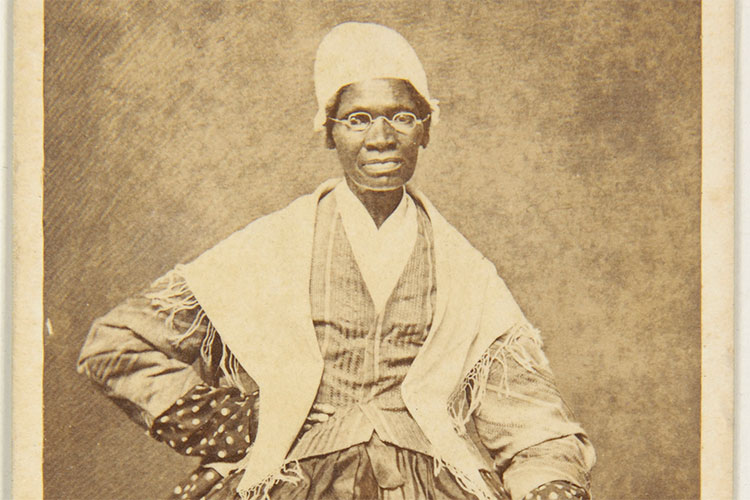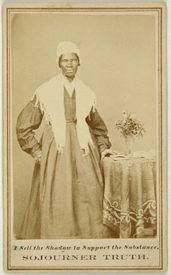Shadows on display: Sojourner Truth at BAMPFA
Starting Wednesday, museum-goers will get a chance to meet the abolitionist, women’s rights activist, speaker, entrepreneur, runaway slave and illiterate memoirist through small rectangular photographs that functioned as the social media of their day

July 25, 2016
Starting Wednesday, patrons of the Berkeley Art Museum and Pacific Film Archive will get a chance to meet abolitionist, women’s rights activist, speaker, entrepreneur, runaway slave, and illiterate memoirist Sojourner Truth. Or at least they’ll get to meet the peripatetic truth-teller the same way most 19th century Americans did — through small rectangular photographs called cartes de visite.
Cartes de visite are small, 2½- by 4-inch pieces of cardboard adorned with a photograph that functioned in a similar capacity to modern day business cards. Invented in France in 1854, cartes de visite quickly became popular in the U.S., and were utilized by abolitionists like Truth to disseminate their message.
Before becoming an abolitionist and activist, Truth was born Isabella Baumfree, a slave in upstate New York who actually learned how to speak Dutch before English. A mother of five, Truth stayed in New York until 1826 when, at age 30, she ran away with one of her children. In 1843, she took the name Sojourner Truth, and spent the rest of her life advocating for the abolition of slavery and for women’s rights, as well as teaching skills to freed Southern slaves. Truth was a formidable speaker, and her speech given at the Ohio Women’s Rights Convention in Akron in 1851 — which would eventually come to be known as “Ain’t I A Woman”— is to this day one of the most iconic pieces of women’s rights rhetoric.
Not only are the cartes being displayed at BAMPFA remarkable images worthy of artistic examination, they’re also indicative of the savvy that Truth possessed in manipulating the media of the time as well as the sophistication of her message. On one carte, Truth announces the reclamation of her self with the caption “I Sell the Shadow to Support the Substance.”
“She is claiming ownership in multiple ways,” says UC Berkeley art history professor Darcy Grimaldo Grigsby about the caption. “She does it by using her full name, the name she chose for herself. She was a woman who had been property, but with the caption she is seizing the first-person — I. She also is claiming ownership with the word sell. She is the one in charge of the transaction now — but she’s not selling herself the same way that she had been sold into slavery, she’s selling her shadow to support her substance. Her substance walks away from here. You can keep the shadow.”
Grigsby is the author of the book Enduring Truths: Sojourner’s Shadows and Substance. Released last September, the work details Truth’s brilliance in using copyright laws and media to support herself financially and spread her message nationwide. Many of the cartes in the exhibit have been donated by Grisgby to BAMPFA, a collection that first began with an eBay purchase.
“[The sale of cartes de visite] was how Truth, while she was on those long trips around the country where she was speaking out against slavery and promoting women’s suffrage, was able to support herself,” says Grigsby. “Having her cartes de visite copyrighted was something that wasn’t being done at the time. Almost everything then was the property of the photographer, but not Truth. She owned her own image.”
Selected Images from BAMPFA’s upcoming exhibit Sojourner Truth, Photography, and the Fight Against Slavery
‘Heroic blackness’
“I really want schools and young people to come see these cards,” says Grigsby on her hopes for the exhibition. “I’d like people to be able to walk in and see heroic blackness in activism from over 150 years ago. It’s a great way to get the conversation started about the multiple uses of photography in political movements, specifically of, by and for African Americans.”
The collection features over 80 pieces, including nine with images of the legendary abolitionist. In conjunction with the exhibit, there will be a number of public programs at BAMPFA, including a carte de visite workshop at 2 p.m. on Sunday, July 31, where people can create their own cartes; a roundtable discussion about the role of photography in the African American struggle for political change with Grigsby, UC Berkeley African American studies professor Leigh Raiford and photographer/photography historian Makeda Best of the California College of the Arts; and a screening of UC Irvine professor Frank B. Wilderson III’s critical documentary about the loss shouldered by the 21st century descendants of slaves, Reparations…Now.










